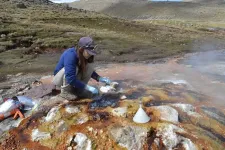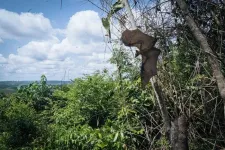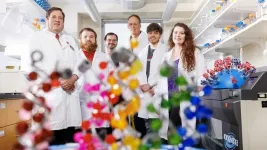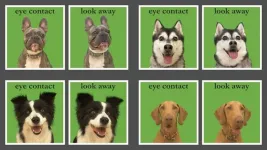(Press-News.org) Researchers have long thought that once a cell starts down its path of differentiation, growing into a skin cell or a liver cell or a neuron, that path could not be changed.
But over the past two decades, scientists have realized this pathway is more complex. Now, using zebrafish as a model, a University of Michigan research team has discovered that a loop in the body's mitochondria—organelles within cells that produce energy for the body—may allow cells to retreat up the path of differentiation. Their results are published in the Proceedings of the National Academy of Sciences.
"Cell fate and differentiation are similar to a ball running down a hill. The ball is the stem cell. The stem cell divides and becomes a progenitor cell, which will become the future skin, neuron, liver, muscle cell. That the ball only ran from uphill to downhill was the idea for a long time," said Cunming Duan, U-M professor of molecular, cellular and developmental biology and director of the undergraduate program in neuroscience.
"People also thought this was true of adult tissue regeneration. If you cut your skin or injured a muscle, the idea was that there was this population of adult stem cells doing the same thing: they were a ball rolling down the hill. But starting in the last few decades, researchers have shown that's overly simplistic."
Now, Duan says, researchers understand both that the cell can cross the hill and become a different cell type and that cells can go back up a hill and become a precursor cell to produce more cells. For example, in the human pancreas, cells called alpha cells produce a hormone called glucagon. Beta cells in the pancreas produce the hormone insulin. But alpha cells can become beta cells.
Cells can also dedifferentiate if they are stressed or injured. For example, if a beta cell can dedifferentiate, become a precursor cell and produce more healthy beta cells.
Recent studies have shown that dedifferentiation isn't actually unique: many fully differentiated cells can roll back up the hill if you injure tissue, Duan said. Cancer cells also show this kind of plasticity, which complicates the ability to treat them.
But previous studies understanding the process of dedifferentiation were done in artificial systems, Duan said. You can't surgically remove part of the fish heart or cut out part of a mammalian liver and study the cellular processes. So Duan and his research team developed a model in zebrafish.
In the model, the researchers labeled calcium ion transporting epithelial cells with a green fluorescent protein that illuminates these cells. Using that, they were able to induce these differentiated cells to reenter the cell cycle and visualize the cell dividing, and to particularly zoom in on processes involving the mitochondria.
Mitochondria are often called the "powerhouses" of the cell. They produce ATP, a molecule that carries energy in the cells of all living organisms. But mitochondria do much more than that, Duan said. When they break down sugar to produce ATP, they also produce what's called reactive oxygen species or ROS, highly reactive chemicals that can cause cellular damage.
However, when mitochondria release mitochondrial ROS, in the correct amounts, they act as signaling molecules. The team found that when cell dedifferentiation and proliferation were induced, ATP production was increased and mitochondrial ROS levels went up in these cells.
When the ROS levels go up, an enzyme that plays a role in cellular stress response called Sgk1 also increases in the cell's cytoplasm. Then, Sgk1 moves from the cytoplasm into the mitochondria, where it phosphorylates the enzyme that synthesizes ATP and triggers ATP production.
To test this loop's impact on the cell's ability to dedifferentiate, the researchers blocked each step in this cycle.
"We feel this is actually required for the cell to roll back in the cell cycle," Duan said. "In our system, if we knock out the ATP protein enzyme, if we knock out Sgk1, if we block the ROS production—if we block any of the steps, the cell can no longer go back in the cell cycle."
The researchers then examined this mitochondrial loop in living human breast cancer cells and found that the same steps took place in human breast cancer cells. This suggests that this is a commonly preserved mechanism that is useful to most cells, they say.
And cancer cells are one type of cell Duan and his team hopes the discovery could someday target. Understanding cell plasticity is important in regenerative biology for tissue regeneration, but it's also important for diseases such as cancer.
"Cancer cells also have this kind of plasticity, and it's regarded as one of the major challenges of why we can't easily treat cancer cells. If you eliminate one cancer stem cell, another can come back," Duan said.
Next, Duan hopes to better understand this mitochondrial loop in other cell types, with the idea that the pathway can be targeted someday both for tissue regeneration and to prevent abnormal growth, such as cancer.
"Cells and animals are far more resilient than we realized. They're far more plastic. We used to think that they were kind of rigid," he said. "Mitochondria plays a far more important role in the cell than we ever thought it would play. We found a very intricate pathway that works at a subcellular level and that dictates the cell's ability to be resilient and to be plastic."
The first and second authors of the study are Yingxiang Li and Chengdong Liu, two postdoctoral researchers in the Duan lab. Other co-authors include undergraduates Luke Rolling, Veronica Sikora, Jack Gurwin and Caroline Barabell in the Duan lab, and researcher Zhimin Chen in Jiandie Lin's lab at the Life Sciences Institute.
Study: ROS signaling-induced mitochondrial Sgk1 expression regulates epithelial cell renewal
END
Finding clues about the process of cell plasticity
2023-06-06
ELSE PRESS RELEASES FROM THIS DATE:
Tectonics matter: USU geoscientists probe geochemistry, microbial diversity of Peruvian hot springs
2023-06-06
LOGAN, UTAH, USA -- South America’s Andes Mountains, the world’s longest mountain range and home to some of the planet’s highest peaks, feature thousands of hot springs. Driven by plate tectonics and fueled by hot rock and fluids, these thermal discharges vary widely in geochemistry and microbial diversity.
Utah State University geoscientists, along with colleagues from Montana State University, examined 14 hot springs within the southern Andes in Peru and discovered microbial community composition is distinctly different in two tectonic settings. Dennis Newell, associate professor in USU’s Department of Geosciences, and recent USU graduate Heather Upin, ...
To prevent future pandemics, leave bats alone
2023-06-06
A new paper in the journal The Lancet Planetary Health makes the case that pandemic prevention requires a global taboo whereby humanity agrees to leave bats alone—to let them have the habitats they need, undisturbed.
Like the SARS coronavirus outbreak of 2003, the COVID-19 pandemic can be traced back to a bat virus. Whether someone handled or ate an infected bat or was exposed to a bat’s bodily fluids in a cave or some other way, or was exposed to another animal that had been infected by a bat, we will quite likely never know. Even a virus released via a lab accident would still have originally come from ...
Investments advance brain research, name MRI for longtime BrainHealth couple
2023-06-06
The Laurie and Todd Platt BrainHealth Project MRI Scanner will help researchers identify neural markers of improved brain health
Center for BrainHealth® celebrates major contributions reaching more than $1 million to support discoveries of brain improvement biomarkers. This investment in advancing the science of brain health is made possible by Sarah and Ross Perot, Jr., Laurie and Todd Platt and many of their friends.
The Sammons BrainHealth Imaging Center is dedicated to discovering a scalable panel of brain measurements correlating physical changes in the brain with changes in a holistic composite metric of brain ...
Nebraska scientists closing in on long-lasting swine flu vaccine
2023-06-06
A successful long-term experiment with live hogs indicates Nebraska scientists may be another step closer to achieving a safe, long-lasting and potentially universal vaccine against swine flu.
The results are not only important to the pork industry, they hold significant implications for human health. That’s because pigs act as “mixing vessels,” where various swine and bird influenza strains can reconfigure and become transmissible to humans. In fact, the 2009 swine flu pandemic, involving ...
Bubble, bubble, more earthquake trouble? Geoscientists study Alaska's Denali fault
2023-06-06
LOGAN, UTAH, USA -- The 1,200-mile-long Denali Fault stretches in an upward arc from southwestern Alaska and the Bering Sea eastward to western Canada’s Yukon Territory and British Columbia. The long-lived and active strike-slip fault system, which slices through Denali National Park and Preserve, is responsible for the formation of the Alaska Range.
“It’s a big, sweeping fault and the source of a magnitude 7.9 earthquake in 2002, that ruptured more than 200 miles of the Denali Fault, along with the Totschunda Fault to the east, causing significant damage to remote villages and central Alaska’s infrastructure,” says Utah State University ...
Movement symptoms in dystonia are caused by spinal cord dysfunction
2023-06-06
Many neurological conditions that involve involuntary muscle contractions have long been considered as diseases of the brain. However, both the brain and the spinal cord contain many nerve cells associated with movement.
The research, published in Science Translational Medicine, used state-of-the-art mouse genetics to distinguish whether the brain or spinal cord was responsible for the disorganisation of movement experienced by dystonia patients.
Focusing on the most common inherited form of dystonia called DYT1, UCL scientists confined a genetic mutation to the spinal cord of the ...
Why are dog breeds with innate diseases popular?
2023-06-06
Flat-faced dogs, such as French and English Bulldogs, are extremely popular despite suffering from severe innate diseases. Hungarian researchers have attempted to uncover the explanation for this paradox. In the end, they concluded that although enthusiasts of flat-faced dogs are aware of the health issues and strive to provide the best for their dogs, they are likely to normalize health problems.
The French and English Bulldogs are among the most popular breeds in both the United States and Europe, but Pugs ...
Nursing home dementia residents’ care linked to majority presence, UC Irvine-led study finds
2023-06-06
Irvine, Calif., June 6, 2023 — The quality of care for nursing home residents with Alzheimer’s disease and related dementias is best when they are in the majority, but most facilities also accommodate a heterogeneous population, where specialized staff training is limited, according to a study led by the University of California, Irvine.
“Recognizing and managing the complex medical conditions and behavioral symptoms of residents with ADRD require enhanced knowledge among staff. These findings raise significant concerns regarding the level of care and quality of life for the majority of these people, highlighting ...
SRF operations earns certification to ensure customer satisfaction
2023-06-06
NEWPORT NEWS, VA – An important certificate now hangs on the wall of the Superconducting Radiofrequency Operations group at the U.S. Department of Energy’s Thomas Jefferson National Accelerator Facility.
SRF Operations builds cryomodules and other particle accelerator parts for the lab’s very own Continuous Electron Beam Accelerator Facility (CEBAF), a DOE Office of Science user facility. The group also supports user facilities at other DOE labs, including SLAC National Accelerator Laboratory and Oak Ridge National Laboratory. This piece of paper represents the department’s dedication to supplying ...
Two new studies identify promising pathways to treat chronic COVID-19
2023-06-06
Philadelphia, June 6, 2023 – Early studies of COVID-19 focused on the acute phase of the disease. However, attention has now turned to the long-term consequences of the disease, which are also significant causes of morbidity and mortality. Two studies reported in The American Journal of Pathology, published by Elsevier, seek to understand the drivers of the chronic and sometimes progressive phase of the disease and identify possible pathways for drug treatment.
The COVID-19 pandemic has highlighted ...






